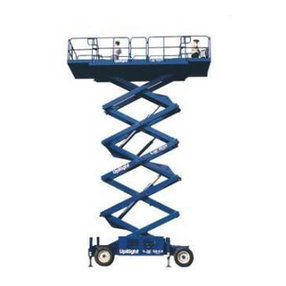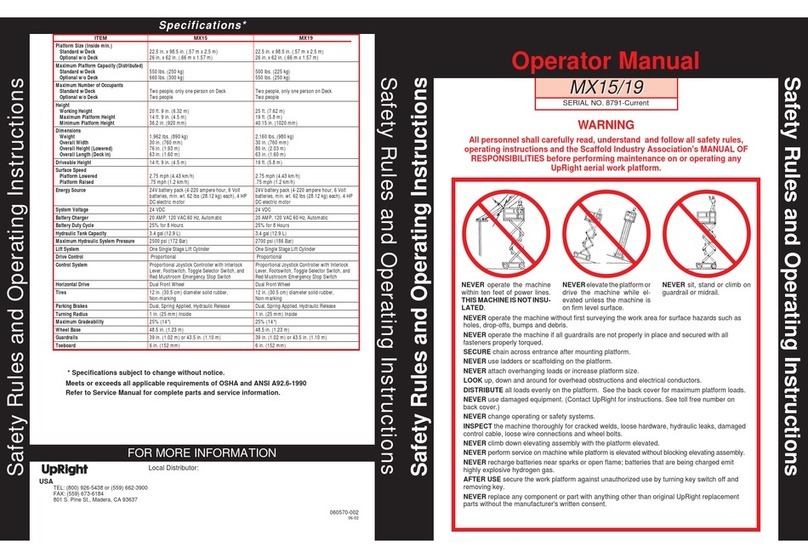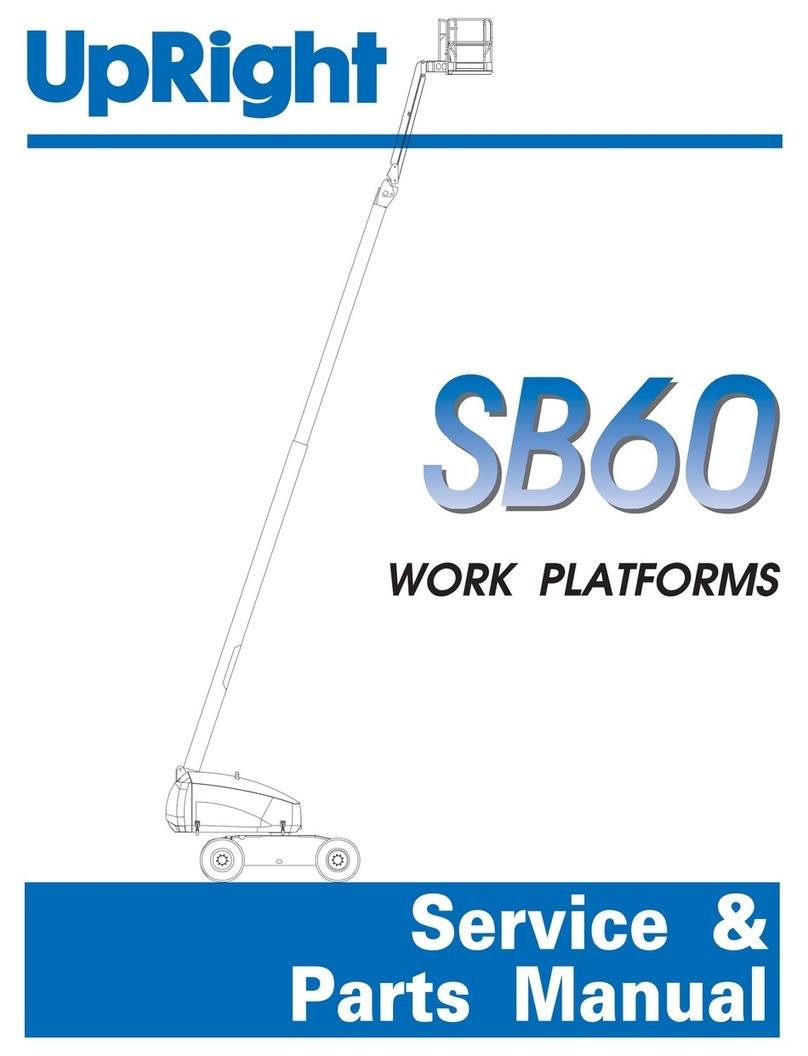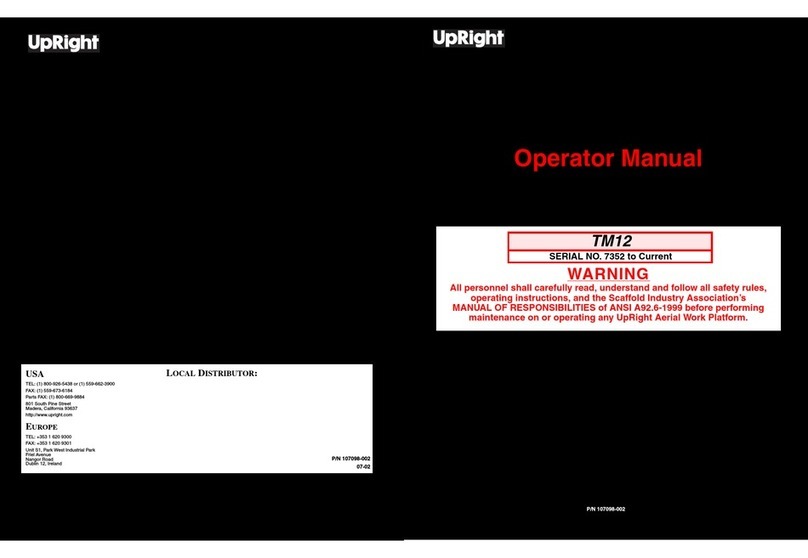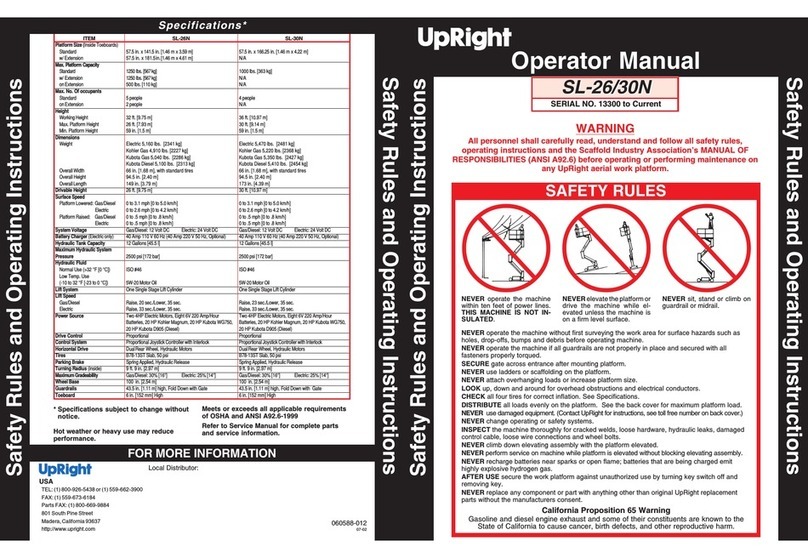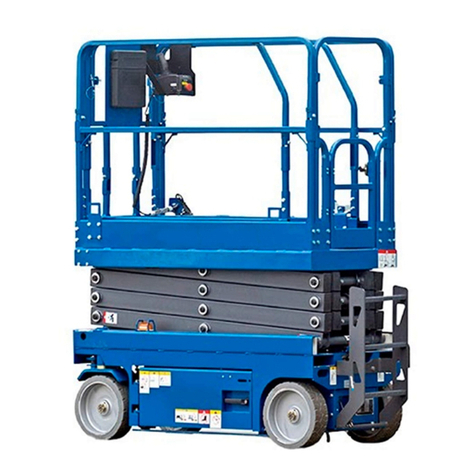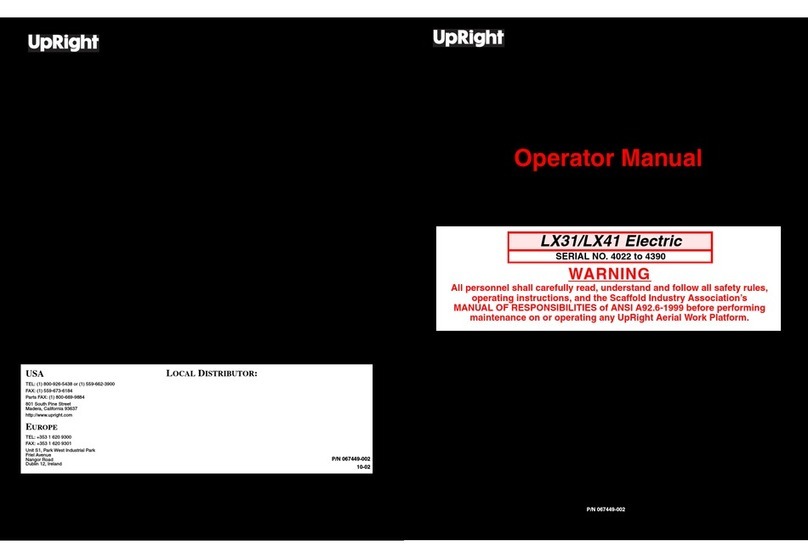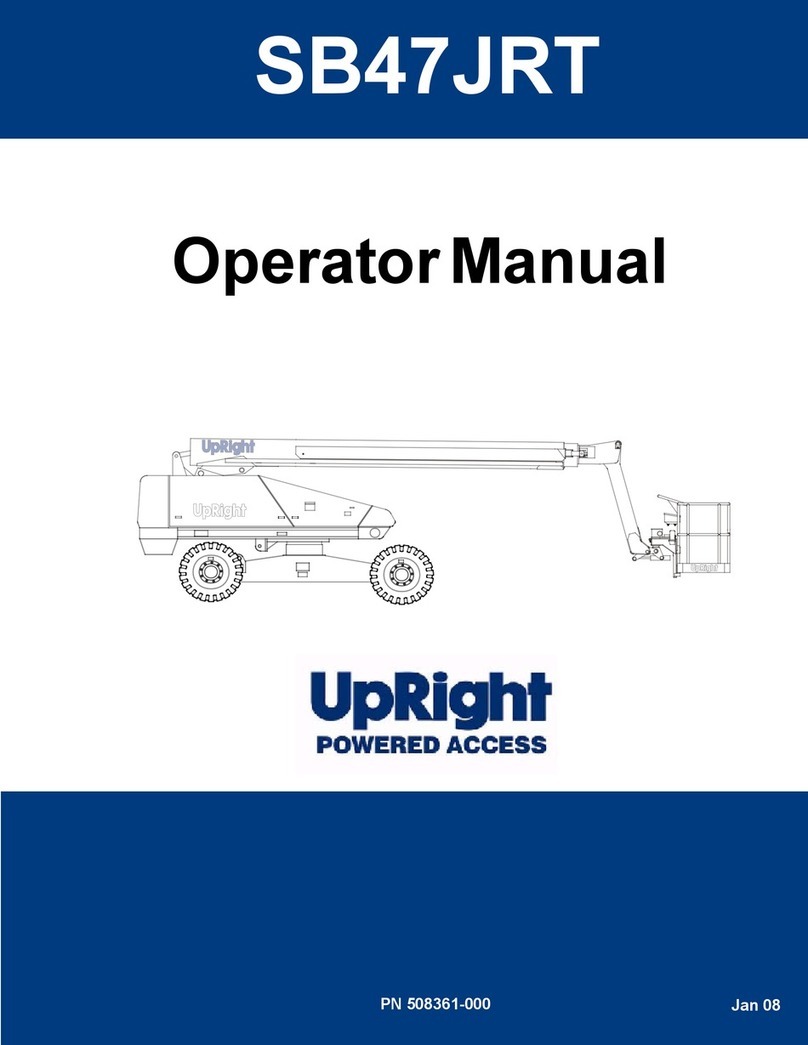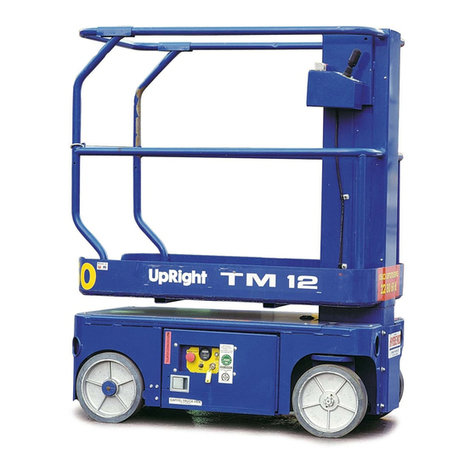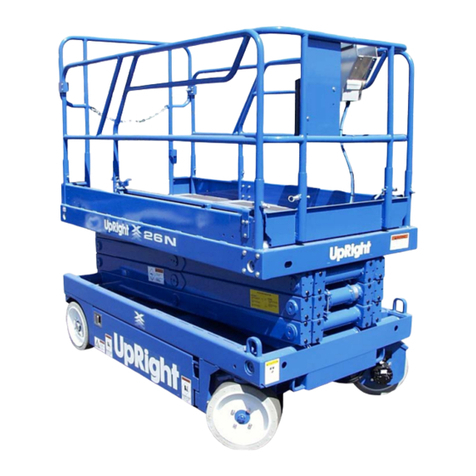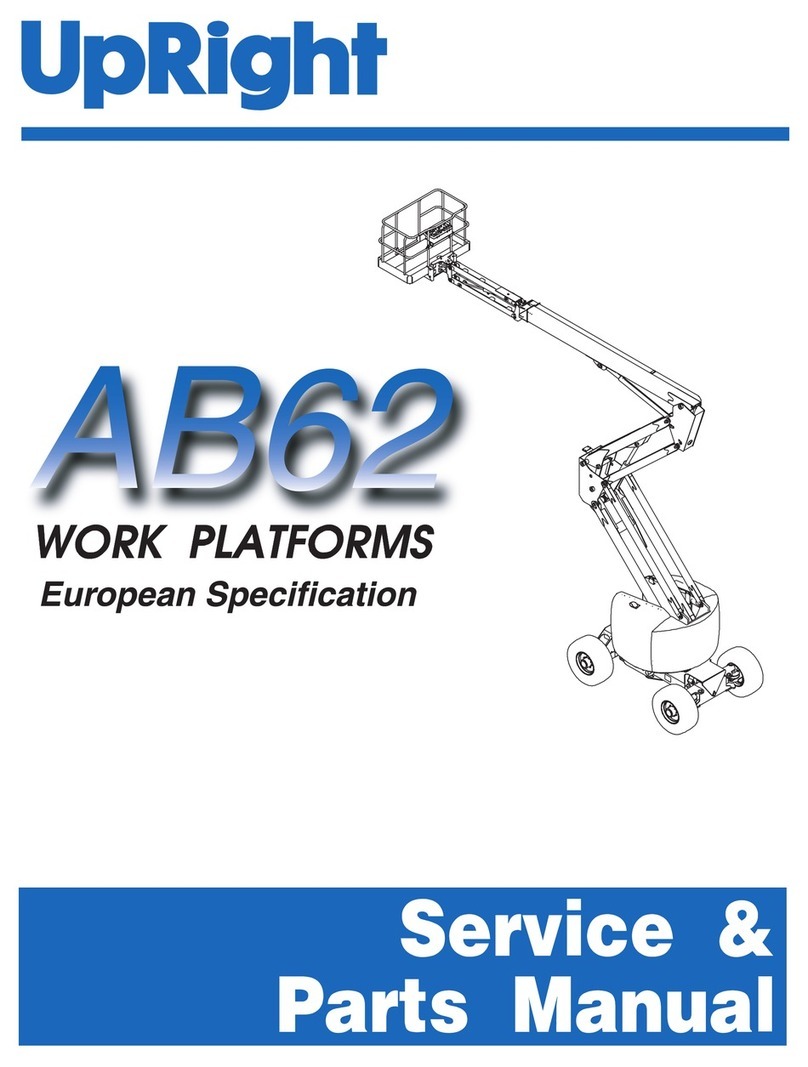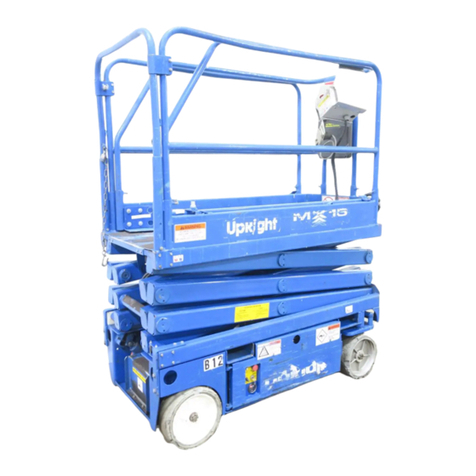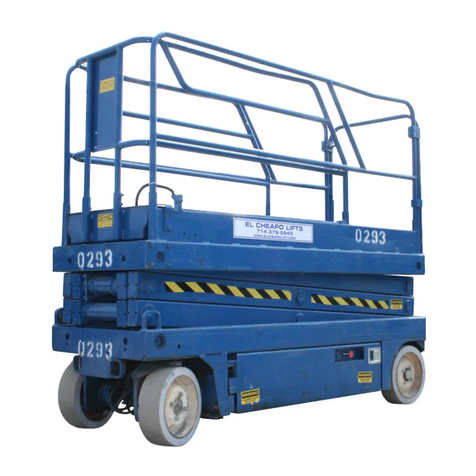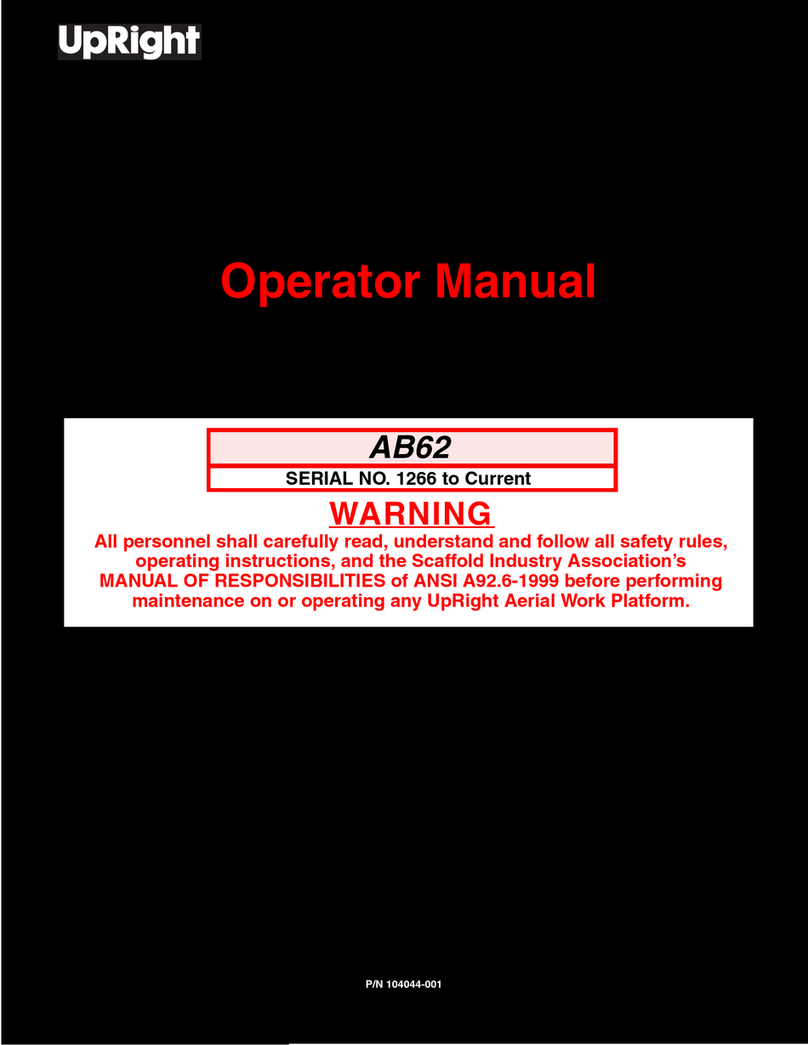Battery
Check electrolyte level 6m
Clean exterior & terminals 3m
Check battery cable condition Daily
Engine Oil
and Filter
Check level and condition Daily
Check for leaks Daily
Change oil filter 00h
Engine Fuel
System
Check fuel level Daily
Check for leaks Daily
Replace fuel filter 6m
Check air cleaner Daily
Engine
Coolant Check coolant level (with engine cold) Daily
Replace coolant 3m
HydraulicOil
(*See note)
Check oil level Daily
Change filter 6m
Drain and replace oil 2y
Hydraulic
System
Check for leaks Daily
Check hose connections 30d
Check hoses for exterior wear 30d
Emergency
Hydraulic
System
Operate the emergency loweringvalve and check
for serviceability Daily
Controller Check switch operation Daily
Control
Cable Check the exterior ofthe cable for pinching, binding
or wear Daily
Platform
Deck and
Rails
Check fasteners for proper torque Daily
Check welds for cracks Daily
Check condition of operators manual Daily
Check condition of anchorage points Daily
Check condition of deck Daily
Tires
Check for damage Daily
Check air pressure (100 psi) [7 bar] Daily
Check lug nuts (torque to 260 ft. lbs. [352 Nm]) 30d
Hydraulic
Pump
Wipeclean 30d
Check for leaks at mating surfaces 30d
Check for hose fitting leaks Daily
Check mounting bolts for proper torque 30d
Hydraulic
Drive
System
Check hydraulic drive motor operation Daily
Check hoses, fittings, and valve block for leaks Daily
Preventative Maintenance Report
Date: __________________________________
Owner:_________________________________
Model No: ______________________________
Serial No:_______________________________
Serviced By:_____________________________
Service Interval:__________________________
Steering
System
Check hardware & fittings for proper torque 6m
Check linkage for wear areas 30d
Check for missing/loose retainers Daily
Check steering cylinder for leaks 30d
Elevating
Assembly
Inspect for structural cracks Daily
Check pivot points for wear 30d
Check pivot pin retaining bolts for proper torque 30d
Check members for deformation Daily
Chassis
Check hoses for pinch or rubbing points Daily
Check component mounting for proper torque 6m
Check swing bearing bolt (torqueto 190 ft/lbs) 6m
Check welds forcracks Daily
Lift
Cylinders
Check the cylinder rods for wear 30d
Check pivot pin pivot bolts for proper torque 30d
Check seals for leaks 30d
Inspect pivot points for wear 30d
Check fittings for proper torque 30d
Turret
Check ring gear for proper lubrication and wear Daily
Check planetary oil level 150h/3m
Lubricate ring gear (MoS2 grease) 150h/3m
Torque Hubs
Check for leaks Daily
Check oil level 250h/6m
Change oil after break-in period 50h/30d
Change oil (SAE 90 wt. gear oil) 2000H/
2Y
Entire Unit
Check for and repair collision damage Daily
Check fasteners for proper torque 3m
Check for corrosion-remove and repaint 6m
Lubricate 30d
Labels Check for peeling, missing, or unreadable labels &
replace Daily
*Use Mobil DTE 15M, ISO grade 46 for temperature range of 40°f to 100°f.
For colder climates use Mobil 13M, ISO grade 32, for temperature range of
10° to 65°f.
15
INTRODUCTION
This manual covers the operation of internal com-
bustion powered models of the SB-80 Boom. This
manual must be stored on the machine at all times.
PRE-OPERATION & SAFETY INSPECTION
Carefully read, understand and follow all
safety rules, labels, and operating instruc-
tions, then perform the following steps each
day before use.
Perform a complete visual inspection of the entire
unit prior to operating. Check the following areas for
discrepancies:
1. Open panels and check hydraulic components/hoses
for damage or leaks. Check electrical components/wir-
ing for damage or loose connections.
2. Inspect chassis, axles, hubs, and steering linkage for
damage, deformation, buckled paint, loose or missing
hardware, and cracked welds.
3. Check tires for damage, punctures, and inflation;tire
pressure must be 100 psi (7 bar).
4. Check all hoses/cables for wear.
5. Inspect elevating assembly for damage, deformation,
buckled paint, loose or missing hardware, and cracked
welds.
6. Inspect platform and guardrails for damage, deforma-
tion, buckledpaint, loose or missing hardware, and
cracked welds. ensure that gate operates freely and
latches securely.
7. Check Hydraulic fluid level with platform fully lowered.
8. Check fluid level in batteries (see
battery maintenance
,
page 9).
9. Checkfuel level,add fuelif necessary (see
fueling
,page
9).
10. Check engine oil level.
11. Check air filter, replace if necessary.
12. Set gasoline/propane selector to desired position. Set
to center position to purge the system when switching
fuels.If themachine isto beoperatedonpropane,open
the supply valve on the tank
Note: When using LP gas, use clean, water-
free liquid petroleum gas, preferably from a
bulk storage tank.
13. Ensure that radiator is cold, check coolant level. Add if
necessary
.
SYSTEM FUNCTION INSPECTION
Note: Refer to figures 1 through 5 for chas-
sis and platform control locations.
Important: Before performing the System
Function Inspection, be sure the axles are
fully extended. For axle extending instruc-
tions, refer to “Extending and Retracting
Axles” (Page 5).
1. Before performing the following tests, check area
around machine and overhead for obstructions, holes,
drop-offs, and debris.
2. Turn chassis key switch to chassis, and pull outemer-
gency stop switches at the chassis control panel and at
the platform control panel.
3. Retract locking bolt. See figure 1.
4. Press the engine start button to crank the engine;
release when engine starts. If engine is cold: press the
glow plug button and hold for 20seconds prior to start-
ing diesel models.
5. Push in the chassis emergency stop button, engine
should stop. Repeat for platform emergency stop but-
ton. Return bothemergency stop buttons to the on
position, and start engine.
6. Operate each function switch to raise / lower, extend /
retract, rotate left / right, each section of the elevating
assembly and observe the operation of the machine. All
functions should operate through full cycle smoothly.
7. Turn chassis key switch to platform.
8. Mount the platform, and attach approved fall restraint
to designated platform anchorage point. Attach only
one fall restraint to each point.
Figure 1: Locking Pin
NEVER remove the cap from a hot radiator.
Hot coolant can cause severe burns.
:$51,1*
If you smell propane, close the supply valve on
the tank immediately until you have located
and corrected the leak.
:$51,1*
2
